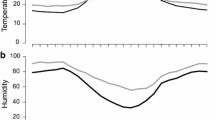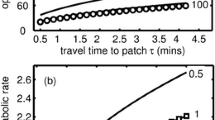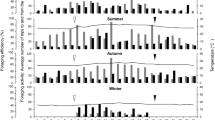Abstract
The energy currencies used by foraging animals are expected to relate to the energy costs and benefits of resource collection. However, actual costs of foraging are rarely measured. We measured the ratio of energetic benefit relative to cost (B/C) during foraging for the giant tropical ant, Paraponera clavata. The B/C ratio was 3.9 for nectar-foragers and 67 for insect prey foragers. In contrast, the B/C ratio during foraging for seed harvester ants (Pogonomyrmex occidentalis) is over 1000, demonstrating that the B/C ratio can vary widely among ants. The B/C ratio was 300 times lower for nectar-foraging Paraponera than for the seed-harvesting Pogonomyrmex because of: (1) a 5-fold lower energetic benefit per trip, (2) a 10-fold greater cost due to longer foraging distances, and (3) a 6-fold greater energy cost per meter due to larger body size. For Paraponera daily colonial energy intake rates are similar to expeditures and may limit colony growth and reproduction. In contrast, for Pogonomyrmex energy intake rates are an order of magnitude higher than estimated costs, suggesting that Pogonomyrmex colonies are unlikely to be limited by short-term energy intake. We suggest that variation in individual B/C ratios may explain why the foraging behavior of Paraponera but not Pogonomyrmex appears sensitive to foraging costs.
Similar content being viewed by others
References
Baroni-Urbani C, Nielsen MG (1990) Energetics and foraging behavior of the European seed harvesting ant Messor capitus. II. Do ants optimize their harvesting? Physiol Entomol 15:449–461
Bartholomew GA, Lighton JRB, Feener DH (1988) Energetics of trail running, load carriage and emigration in the column-raiding army ant, Eciton hamatum. Physiol Zool 61:57–68
Breed MD, Bennett B (1985) Mass recruitment to nectar sources in Paraponera clavata: a field study. Insectes Soc 32:198–208
Breed MD, Harrison JF (1988) Worker size, ovary development and division of labor in the giant tropical ant, Paraponera clavata (Hymenoptera: Formicidae) J Kans Entomol Soc 61:285–290
Breed MD, Fewell JH, Moore AJ, Williams KR (1987) Graded recruitment in a ponerine ant. Behav Ecol Sociobiol 20:407–411
Carroll CR, Janzen DH (1973) Ecology of foraging by ants. Annu Rev Ecol Syst 4:231–258
Chadab R, Rettenmeyer CW (1975) Mass recruitment by army ants. Science 188:1124–1125
Christ TO, MacMahon JA (1991) Foraging patterns of Pogonomyrmex occidentalis (Hymenoptera: Formicidae) in a shrubsteppe ecosystem: the roles of temperature, trunk trails, and seed resources. Environ Entomol 20:265–275
Feener DH, Lighton JRB (1991) Is foraging in the desert ant, Messor pergandei (Hymenoptera: Formicidae), limited by water? Ecol Entomol 16:183–191
Fewell JH (1988a) Energetic and time costs of foraging in harvester ants, Pogonomyrmex occidentalis. Behav Ecol Sociobiol 22:401–408
Fewell JH (1988b) Variation in the foraging patterns of the ant, Pogonomyrmex occidentalis in relation to variation in habitat structure. In: Jeanne RL (ed) Inter-individual variation in social insect behavior. Westview Press, Boulder, pp 257–282
Fewell JH (1988c) Foraging in Pogonomyrmex occidentalis: costs, currencies and constraints. Ph. D. dissertation, University of Colorado, Boulder
Fewell JH, Ydenberg RC, Winston ML (1991) Individual foraging effort as a function of colony population in the honey bee, Apis mellifera L. Anim Behav 42:153–155
Fewell JH, Harrison JF, Stiller TM, Breed MD (1992) Distance effects on resource profitability and recruitment in the giant tropical ant, Paraponera clavata. Oecologia 92:542–547
Harrison JM (1986) Caste-specific changes in honeybee flight capacity. Physiol Zool 59:175–187
Harrison JF, Fewell JH, Stiller TM, Breed MD (1990) Effects of experience on use of orientation cues in the giant tropical ant. Anim Behav 37:869–870
Heinrich B (1975) Energetics of pollination. Annu Rev Ecol Syst 6:139–170
Hermann HR (1975) Crepuscular and nocturnal activities of Paraponera clavata. Entomol News 86:94–99
Hölldobler B (1976) Recruitment behavior, home range orientation and territoriality in harvester ants, Pogonomyrmex. Behav Ecol Sociobiol 1:3–44
Hölldobler B (1985) Liquid food transmission and antennation signals in ponerine ants. Isr J Entomol 19:89–99
Janzen DH, Carroll CR (1983) Paraponera clavata. In: Janzen DH (ed) Costa Rican, Natural History. University of Chicago Press, Chicago, pp 752–753
Jorgensen CD, Porter SD (1982) Foraging behavior of Pogonomyrmex owyheei in southeast Idaho. Environ Entomol 11: 381–384
Kelrick MI, MacMahon JA, Parmenter RR, Sisson DV (1986) Native seed preferences of shrub-steppe rodents, birds and ants: the relationships of seed attributes and seed use. Oecologia 68:327–337
Lavigne RJ (1969) Bionomics and nest structure of Pogonomyrmex occidentalis (Hymenoptera: Formicidae). Ann Entomol Soc Am 62:1166–1175
Lighton JRB, Bartholomew GA (1988) Standard energy metabolism of a desert harvester ant, Pogonomyrmex rugosus: effects of temperature, body mass, group size, and humidity. Proc Natl Acad Sci USA 85:4765–4769
Lighton JRB, Feener DH (1989a) A comparison of energetics and ventilation of desert ants during voluntary and forced locomotion. Nature 342:174–175
Lighton JRB, Feener DH (1989b) Water-loss rate and cuticular permeability in foragers of the desert ant Pogonomyrmex rugosus. Physiol Zool 62:1232–1256
Lighton JRB, Bartholomew GA, Feener DH (1987) Energetics of locomotion and load carriage and a model of the energy cost of foraging in the leaf-cutting ant Atta colombica Guer. Physiol Zool 60:524–537
Lighton JRB, Weier JA, Feener DH (1993) The energetics of locomotion and load carriage in the desert harvester ant Pogonomyrmex rugosus. J Exp Biol 181:49–61
McCluskey ES, Brown WL (1972) Rhythms and other biology of the giant tropical ant Paraponera. Psyche 79:335–347
McCoy ED, Kaiser BW (1990) Changes in foraging activity of the southern harvester ant Pogonomyrmex badius (Latreille) in response to fire. Am Midl Nat 123:112–123
Nielsen MG, Baroni-Urbani C (1990) Energetics and foraging behavior of the European seed harvesting ant Messor capitus. I. Respiratory metabolism and energy consumption of unloaded and loaded workers during locomotion. Physiol Entomol 15:441–448
Nielsen MG, Jensen TF, Holm-Jensen I (1982) Effect of load carriage on the respiratory metabolism of running worker ants of Camponotus herculeanus (Formicidae). Oikos 39:137–142
Otis GW, Winston ML, Taylor OR (1981) Engorgement and dispersal of Africanized honeybee swarms. J Apic Res 20:3–12
Rissing SW, Pollack GB (1984) Worker size variability and foraging efficiency in Veromessor pergandei (Hymenoptera: Formicidae). Behav Ecol Sociobiol 15:121–126
Rogers LE (1972) The ecological effects of the western harvester ant (Pogonomyrmex occidentalis) in the shortgrass plains ecosystem (USIBP Tech Rep 206).
Schmid-Hempel P, Kacelnik A, Houston AI (1985) Honeybees maximize efficiency by not filling their crops. Behav Ecol Sociobiol 17:61–66
Schoener TW (1971) Theory of feeding strategies. Annu Rev Ecol Syst 2:369–404
Slansky F Jr, Scriber JM (1985) Food consumption and utilization. Comp Insect Physiol Biochem Pharmacol 4:87–163
Stephens D, Krebs J (1986) Foraging theory. Princeton University Press, Princeton
Withers PC (1992) Comparative animal physiology. Saunders College, Orlando
Young AM (1977) Notes on the foraging of the giant tropical ant, Paraponera clavata, on two plants in tropical wet forest. J G Entomol Soc 12:41–51
Young AM, Hermann HR (1980) Notes on foraging of the giant tropical ant Paraponera clavata. J Kans Entomol Soc 53:35–55
Author information
Authors and Affiliations
Corresponding author
Rights and permissions
About this article
Cite this article
Fewell, J.H., Harrison, J.F., Lighton, J.R.B. et al. Foraging energetics of the ant, Paraponera clavata . Oecologia 105, 419–427 (1996). https://doi.org/10.1007/BF00330003
Received:
Accepted:
Issue Date:
DOI: https://doi.org/10.1007/BF00330003




